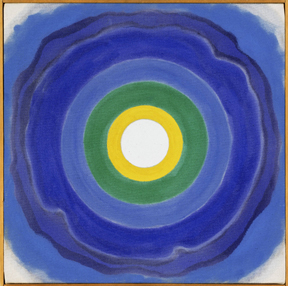Friday, September 21, 2012
LYRICAL COLOR: MORRIS LOUIS, GENE DAVIS, KENNETH NOLAND
The Phillips Collection played a pivotal role in offering Washington Color School artists exposure to modern art. These Washington artists frequently visited the museum and found inspiration in the vibrant, light-filled paintings by Pierre-Auguste Renoir, Pierre Bonnard, Henri Matisse, Paul Klee, and, later, Mark Rothko. In celebration of the first major modern art movement to come out of Washington and the influential role of The Phillips Collection on its development, the museum displayed more than 20 Color School paintings and works on paper from April 14 to July 19, 2007. Lyrical Color: Morris Louis, Gene Davis, Kenneth Noland, and the Washington Color School was part of the citywide festival ColorField.remix.
The museum’s close proximity to several galleries and artists’ workshops made it an ideal location for Washington Color School artists to interact with and experience the collection. Morris Louis, Kenneth Noland, Gene Davis, and other key figures in the 1950s and 1960s Color Field movement particularly admired Klee, often recalling the lasting impression his work made on them. Klee’s experiments with surface and texture, in works such as
Arab Song (1932), painted directly on burlap, influenced these artists who would later stain raw canvas.
Emphasizing the relationship between color, surface, and structure, Washington Color School artists experimented with a technique of staining the canvas, through pouring or painting, and used new materials such as thinned water-based paint and unprimed cotton duck canvas. The movement stylistically favored single image formats, all-over design, monumental scale, and, most importantly, expressive color.
Founder Duncan Phillips championed Noland’s work early on. Noland himself credited the museum with helping him develop his mature style. Phillips purchased the first Noland to enter a public collection,
Inside (1950), and also acquired
In the Garden (1952), which the artist acknowledged was painted under the influence of the Klee works at the museum. By 1958, Noland started painting centralized, target-like images, such as
April (1960).
The radiating bands of color recall the life-giving force of the sun in Arthur Dove's Me and the Moon (1937), or Georgia O'Keeffe's Red Hills, Lake George (1927), both of which Noland saw at The Phillips Collection.
In 1963, Duncan Phillips purchased
Louis’ Number 182 (1961), from his well-known Stripe series, choosing to display the painting as a prominent example of contemporary art, in his recently completed Annex building. The Stripe paintings concentrated on the effects of overlapping, separating, transparent and opaque color, and in Number 182 Louis poured vertical bands into layered stacks. Depending on the placement and thickness of the paint, the stripes jostle, push and interact with one another. By manipulating a new acrylic called Magna, which was thinned with turpentine, color absorbed into the unsized and unprimed canvas weave, integrating material with support.
Davis enjoyed spending leisurely weekend afternoons at The Phillips Collection, admiring the landscapes of John Constable, Gustave Courbet, and Chaim Soutine, and the color harmonies of Matisse, Bonnard, and Renoir. He was fervent in his devotion to the Phillips and attributed his mastery of color to the collection, saying "what constituted color in painting came directly from the French-oriented painting that Mr. Phillips seemed to be fond of." Davis never received formal art training, but rather learned about art through publications and collections. After experimenting with Abstract Expressionism, stripes began to appear in Davis’s work. During this time, Davis was influenced by other Color Field artists, as well as works by Klee that he saw at the Phillips, such as Botanical Laboratory (1928), and Tree Nursery (1929).
Lyrical Color: Morris Louis, Gene Davis, Kenneth Noland, and the Washington Color School honored the achievements of the Washington Color School Painters. More than 30 Washington area museums, galleries, arts organizations, and businesses will participate in ColorField.remix, a citywide festival of exhibitions, installations, and lectures. It was the largest celebration of painting ever held in Washington.
Gene Davis' Black Grey Beat
Gene Davis' Black Flowers
See more here and here.






